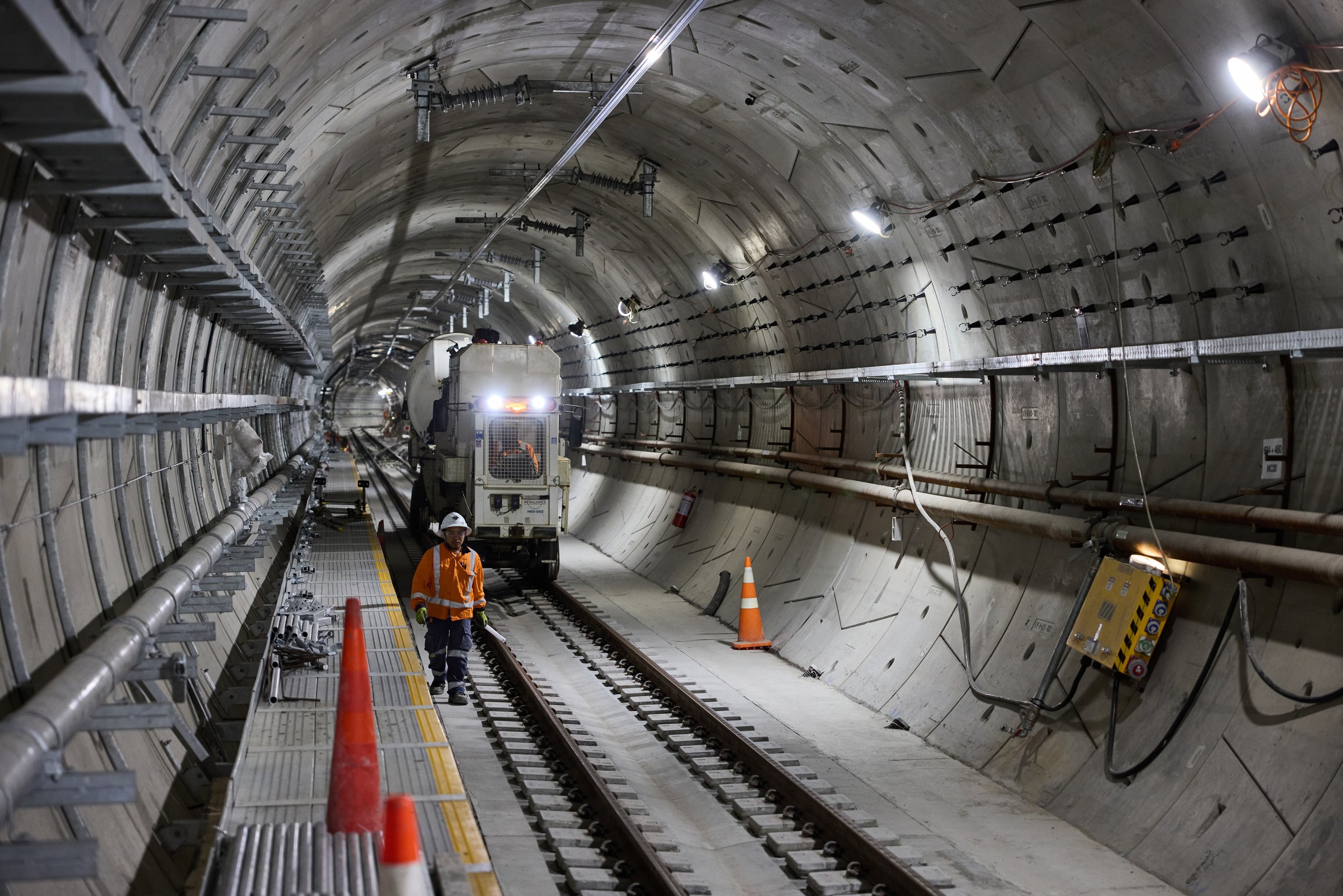March 2024
“New Zealand has never built an underground metro railway before. Simply put, it is a case of not knowing what we don’t know until we test it. ”
In many different ways there has been a significant shift for City Rail Link these past 12 months that is having a profound and dynamic impact on the delivery of a world class and game-changing railway for the people of Auckland.
The biggest change affecting all CRL sites is the project’s switch from heavy civil engineering works, which had dominated the project from almost day one, to one where the installation of all the systems – including signaling, lighting, communications and fire protection - needed to run a railway safely and successfully is underway.
Two noteworthy events highlight our rapid transition: we’ve just completed installation of our second track underground – the northbound line from Maungawhau Station at Eden Terrace to downtown’s Waitematā Station (Britomart); and last Christmas Eve, Te Waihorotiu in the central city became the first of our new stations to be “energized” with a permanent supply of power – 22 thousand volts of electricity to fuel every single aspect of what will become the country’s busiest station.
Together these two huge milestones clear the way for the next critical phase of the project – testing and commissioning.
Building CRL in the middle of the country’s largest city was complex and challenging. While heavy construction and all our track laying may now be over, complexities and challenges stay with us as we progress further. Lessons learned from big projects overseas tells us risks remain.
Preparing the existing Auckland rail network for the operation of a completed and brand new CRL requires the integration of new systems, infrastructure and processes into a network that already exists.
Earlier this year, there was a timely reminder that integration is not as simple as connecting one piece of a jigsaw puzzle or one plastic building block with another to get trains running through the CRL tunnels.
During the Christmas break, changes to the signalling system at Waitematā Station were brought forward to align with critical project milestones and workloads across the wider network. That work did, however, have an immediate impact on the number of trains that could safely arrive and leave from the station within a certain period of time. That occurred because the work was set up for the new configuration of Waitematā as a through station which caused some teething issues with Waitematā’s current configuration as terminating or dead end station.
Signalling is but one component of a massive testing and commissioning programme that will take months to complete.
The list is long.
There are 31 different test plans to complete successfully before CRL is safe to make its transport impact on Auckland.
Those plans cover the signal systems, track work, overhead power lines, lighting, station lifts and escalators – New Zealand’s longest escalator is being installed at Karanga-A-Hape Station – fire detection and suppression systems, ventilation, security cameras, communications, and station ticket machines and gates.
All those systems will have to be tested and tested again to make sure they mesh completely with the rest of Auckland’s rail network to do the job they are designed for - keeping everyone safe.
There are five key steps on our testing and commissioning pathway to successful project completion. The pathway includes factory acceptance tests – they’re about 40 per cent complete – and static tests and static integration tests of installed systems and equipment.
Later in the year, test trains will start running in the tunnels under controlled conditions. Auckland train drivers will be operating a train underground and dealing with a variety f scenarios they could encounter below the city. CRL is one of the steepest sections of railway in New Zealand. From Maungawhau the line drops 70 metres to Waitematā, which sits below sea level. At its deepest point, CRL runs 42 metres underneath Auckland’s busy Central Motorway Junction. More than 40 different operational scenarios will need to be safety checked.
Test trains will also give CRL’s operators and the city’s emergency services the opportunity to test and evaluate responses to a wide range of emergency scenarios below ground – again, another new dimension that CRL will bring to Auckland.
Testing and commissioning is not work CRL will complete on its own. Our approach is to collaborate with others. There is an informal Alliance involving City Rail Link Ltd, and Auckland Transport and KiwiRail who will operate and maintain a completed CRL. We will be supported by CRL’s main contractor, Link Alliance, and by Auckland One Rail, the city’s train operator.
Approximately 75 core personnel will lead the testing and commissioning phase. They will share resources and their expertise to get the best possible outcomes for the city by delivering the great dividends everyone wants.
The challenges around testing and commissioning should not be minimised. Our two biggest risks to the practical completion of CRL are individual sub-systems not meeting performance requirements, and a lack of integration with the wider rail network.
That is why our testing and commissioning programme is so comprehensive and thorough. New Zealand has never built an underground metro railway before. Simply put, it is a case of not knowing what we don’t know until we test it.
Nevertheless, CRL has much to celebrate and to reassure people that we are on track. Our work is about 80 percent done. We are ticking off milestone after milestone, marking our rapid progress.
Progress towards the project’s finish line remains intense. We stay committed to completing CRL in November 2025. Underpinning that commitment is a determination that our testing and commissioning programme will allow the project to hand over to Auckland Transport and KiwiRail a City Rail Link that meets the highest standards of safety, is fully fit-for-purpose and will transform travel in Auckland.
This was published first in the New Zealand Herald’s infrastructure/economic supplement, Project Auckland.


